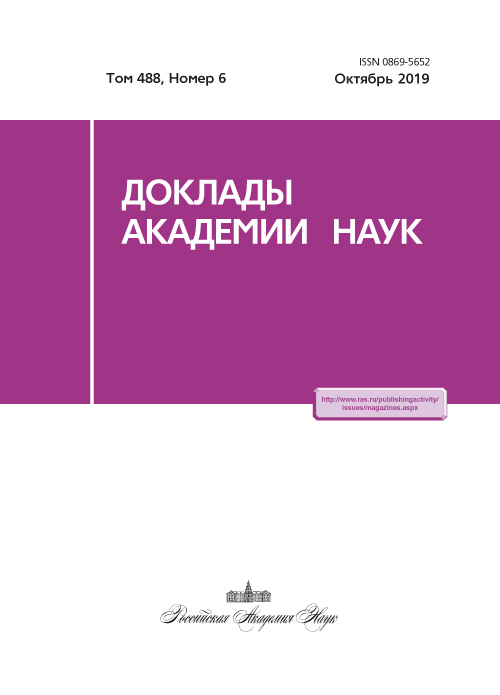Spectral decompositions for the solutions of Lyapunov equations for bilinear dynamical systems
- Authors: Yadykin I.B.1, Iskakov A.B.1
-
Affiliations:
- Institute of Control Sciences of the Russian Academy of Sciences
- Issue: Vol 488, No 6 (2019)
- Pages: 599-603
- Section: Control Processes
- URL: https://journals.eco-vector.com/0869-5652/article/view/17715
- DOI: https://doi.org/10.31857/S0869-56524886599-603
- ID: 17715
Cite item
Abstract
In this paper, novel spectral decompositions are obtained for the solutions of generalized Lyapunov equations, which are observed in the study of controllability and observability of the state vector in deterministic bilinear systems. The same equations are used in the stability analysis and stabilization of stochastic linear control systems. To calculate these spectral decompositions, an iterative algorithm is proposed that uses the residues of the resolvent of the dynamics matrix. This algorithm converges for any initial guess, for a non-singular and stable dynamical system. The practical significance of the obtained results is that they allow one to characterize the contribution of individual eigen-components or their pairwise combinations to the asymptotic dynamics of the perturbation energy in deterministic bilinear and stochastic linear systems. In particular, the norm of the obtained eigen-components increases when frequencies of the corresponding oscillating modes approximate each other. Thus, the proposed decompositions provide a new fundamental approach for quantifying resonant modal interactions in a large and important class of weakly nonlinear systems.
About the authors
I. B. Yadykin
Institute of Control Sciences of the Russian Academy of Sciences
Author for correspondence.
Email: jad@ipu.ru
Russian Federation, 65, Profsoyuznaya street, Moscow, 117997
A. B. Iskakov
Institute of Control Sciences of the Russian Academy of Sciences
Email: isk_alex@mail.ru
Russian Federation, 65, Profsoyuznaya street, Moscow, 117997
References
- Поляк Б.Т., Хлебников М.В., Рапопорт Л.Б. Математическая теория автоматического управления. Учеб. пособие. М.: ЛЕНАНД, 2019. 504 с.
- Васильев С.Н., Косов А.А. Анализ динамики гибридных систем с помощью общих функций Ляпунова и множественных гомоморфизмов // АиТ. 2011. № 6. С. 27-47.
- Baur U., Benner P., Feng L. Model order reduction for linear and nonlinear systems: a system-theoretic perspective // Archives of Comp. Methods in Engineering. 2014. V. 21. № 4. P. 331-358.
- Antoulas A.C. Approximation of Large-Scale Dynamical Systems. Advances in Design and Control. Philadelphia: SIAM, 2005. 479 p.
- Ядыкин И.Б. О свойствах грамианов непрерывных систем управления // АиТ. № 6. 2010. C. 39-50.
- Ядыкин И.Б., Искаков А.Б. Спектральные разложения для решений Сильвестра-Ляпунова-Крейна // ДАН. 2017. Т. 472. № 4. С. 388-392.
- Зубов Н.Е., Зыбин Е.Ю., Микрин Е.А., Мисриханов М.Ш., Рябченко В.Н. Общие аналитические формы решения уравнений Сильвестра и Ляпунова для непрерывных и дискретных динамических систем // Изв. РАН. Теория и системы управления. 2017. № 1. С. 3-20.
- Mohler R.R., Kolodziej W.J. An Overview of Bilinear System Theory and Applications // IEEE Trans. Syst., Man, Cybern. 1980. V. SMC-10. № 10. P. 683-688.
- Пупков К.А., Капалин В.И., Ющенко А.С. Функциональные ряды в теории нелинейных систем. М.: Наука, 1976. 448 с.
- Gray W.S., Mesko J. Energy Functions and Algebraic Gramians for Bilinear Systems. In: Preprints of the 4th IFAC Nonlinear Control Systems Design Symp. Enschede. 1998.
- Al-Baiyat S., Farag, A.S., Bettayeb M. Transient approximation of a bilinear two-area interconnected power system // Electric Power Systems Research. 1993. V. 26. Iss. 1. P. 11-19.
- Zhang L., Lam J. On H2 Model Order Reduction of Bilinear Systems // Automatica. 2002. V. 38. P. 205-216.
- Damm T. Direct Methods and ADI-preconditioned Krylov Subspace Methods for Generalized Lyapunov Equations // Numer. Linear Algebra Appl. 2008. V. 15. P. 853-871.
- Benner P., Damm T. Lyapunov Equations, Energy Functionals and Model Order Reduction of Bilinear and Stochastic Systems // SIAM J. Control Optim. 2011. V. 49. № 2. P. 686-711.
- Schneider H. Positive operators and an inertia theorem // Numerische Mathematik. 1965. V. 7. P. 11-17.
Supplementary files







